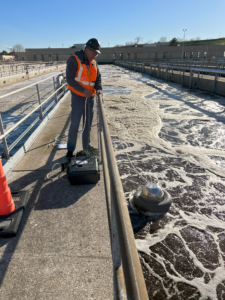How Does Industrial Odor Control Work? A Behind-the-Scenes Look at Real Facility Operations
 Odor control is a challenge for many industrial sites, including wastewater plants, food processing facilities, and chemical manufacturers. Uncontrolled odors can cause complaints from the surrounding community, create regulatory issues, and damage equipment through corrosion. Many facility managers ask a simple but important question: how does industrial odor control work?
Odor control is a challenge for many industrial sites, including wastewater plants, food processing facilities, and chemical manufacturers. Uncontrolled odors can cause complaints from the surrounding community, create regulatory issues, and damage equipment through corrosion. Many facility managers ask a simple but important question: how does industrial odor control work?
At Webster Environmental Associates (WEA), we have spent decades designing and supporting odor control systems. Our experience provides a clear, practical view of how effective programs come together and continue to perform.
Step 1: Finding and Measuring the Sources
Every odor control project starts with identifying where odors are being released. Guesswork rarely works, so we rely on detailed air and liquid sampling. Our engineers use field tools such as hydrogen sulfide (H₂S) and ammonia monitors, odor panels, and dispersion modeling.
This testing process gives us accurate data about the strength, type, and location of odor emissions. Without this information, it is easy to select the wrong equipment or size a system incorrectly. Accurate data is the foundation for any odor control plan that will perform over time.
Step 2: Choosing the Right Treatment Technology
Once we know what we are dealing with, we decide which treatment methods will fit the site. Each facility has unique needs, and no single technology works everywhere.
- Chemical scrubbers are ideal for sites dealing with strong or variable odors. They respond quickly to odor spikes and work well with gases like hydrogen sulfide and ammonia.
- Biofilters or biotrickling scrubbers are the best choice for steady organic odor loads. They use natural microbes to break down odor compounds and have lower operating costs over time.
- Carbon adsorption or hybrid systems work as polishing steps or backups. They capture remaining odor compounds before air leaves the system.
Our team evaluates space constraints, permitting requirements, cost targets, and operational goals when selecting a technology mix.
Step 3: Integrating Airflow, Containment, and Monitoring
Even the best odor control equipment will underperform if it is not supported by proper airflow and containment. Ducts, enclosures, and fans work together to capture odor at its source and move it to the treatment system.
We also build in real-time monitoring to track performance. Sensors measure levels of key gases, allowing us to adjust chemical feed rates, fan speeds, or other system settings as needed. Small design details like duct layout, fan placement, and access points make a big difference in how efficient a wastewater odor control system can be.
Step 4: Long-Term Operation and Maintenance
 Odor control is not a one-time project. Even well-designed systems require care to stay reliable. Regular maintenance is key, including checking filter media, maintaining pumps, and refilling chemicals.
Odor control is not a one-time project. Even well-designed systems require care to stay reliable. Regular maintenance is key, including checking filter media, maintaining pumps, and refilling chemicals.
We also provide staff training. Operators who understand how the system works can spot problems early and complete routine tasks that keep performance consistent. Our support often includes scheduled follow-up visits, remote monitoring, and media replacement programs.
How WEA Helps Industrial Sites Succeed
As industrial odor control engineers, we offer full-service support from the first phone call to long-term operation. Our work includes:
- Site testing and data collection.
- System design and equipment sizing based on actual field conditions.
- Training and support for on-site teams.
- Ongoing monitoring and performance optimization.
We have partnered with utilities, food manufacturers, and chemical plants across the country to solve complex odor challenges. For example, our work with Toho Water Authority and Conway Corporation has helped these utilities meet regulatory standards and improve relations with their surrounding communities. These projects show how a thorough, data-driven approach makes systems more reliable.
Get in Touch With WEA Today
Odor problems rarely go away on their own. They require proper planning, the right equipment, and a commitment to follow-up. By focusing on each step—finding sources, choosing technologies, integrating airflow, and maintaining the system—we help facilities reduce complaints, stay in compliance, and protect their infrastructure.
If your site is dealing with persistent odors, now is the time to act. Contact Webster Environmental Associates to schedule a site assessment. Our team will test your facility, walk you through your options, and help you build a program that works for the long term.
